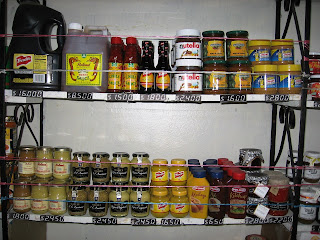A year or so ago I started missing some items not in my local supermarket: caraway seeds (for rye bread), gluten flour (to help my multigrain breads), tomatillos (for Mexican salsa verde) and okra (for gumbo). With help from members of the International Association of Chile I discovered tostadurias: stores specializing in spices, herbs, grains, legumes, fruits, nuts, condiments, and so on. They didn’t have tomatillos or okra – I’m still trying La Vega for those – but they seem to have most everything that one might want in dry and preserved foods.
My favorite, and the one where I eventually found caraway seeds (comino aleman or kumen) is Susana Kuschnir Silva’s in La Vega, Santiago's large public market.
.
.
Photo, front to back, left to right:
Peruvian chili pepper (Ají panca)
Spanish chili[1] (Ají guindilla)
Toasted sesame seeds
Green peppercorns
Cardamom
White sesame seeds
Brown rice
Dried mushrooms (callampas secas)
Toasted Chilean hazelnut (Avellano chileno)
Susana, here surrounded by vanillas, vinegars, soy sauce, mustards, chocolates, agar-agar, jams, oyster sauce, etc., speaks English and has great patience if you need help figuring out how to ask for dried blueberries, or bittersweet chocolate.
There are also Worchester sauce (salsa inglesa), sweet chili sauce, Nutela, Lúcuma paste, peanut butter, mustards and catsups.
Raw peanuts
Wheat mote [2]
Oregano
Instant oatmeal
Goat-horn chili (ají cacho de cabra)
Cacao hulls
Chilean palm (Jubaea chilensis) fruit
Vegetarian “meat” (soy protein)
Garbanzo beans
Lentils
Orange lentils
Green beans
White beans
She also has: quinoa, couscous, bulgur, oats, corn, barley, flax, gluten, dried cherries, dried blueberries, raisins, prunes, dry figs, dry peaches, black and yellow mustard seeds, shelled walnuts, almonds, merken, thyme, sage, chocolate covered orange peel, candied peanuts, anchovies, and of course, caraway seeds. And much more.
It is all weighed to the gram, (by the young lady at right) sealed in plastic bags and priced fairly (and inexpensively, if you are accustomed to supermarket prices.)
.
.
Susana Kuschnir Silva
Artesanos 801, Recoleta, Santiago
Tel. 735-2810 or 737-7821
.
Click on map to enlarge
And if you find tomatillos or okra--bamiyah in Arabic, and something similar among Palestinian-Chileans—let me know.
,
Okra
Tomatillos








.png)





























.png)


